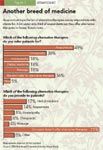Assessing alternative remedies
Today more of your clients dabble in herbal remedies and nutritional supplements. Are pets, and the veterinary practices that treat them, following the trend?
WHEN RELIEF FROM WHAT AILS US CAN'T BE found in traditional medicines—or we want to enhance our wellness routines—more and more people turn to herbal teas, supplements, vitamins, acupuncture, aromatherapy, or massages, just to name a few. In fact, a 2004 report by the Institute of Medicine says nearly 19 percent of Americans used a dietary supplement the year before. And 35 percent of Americans have used some form of alternative medicine according to a 2005 study published by Harvard Medical School.

However, it seems that America's pets aren't necessarily following the same consistent upward trend. True, the 2005/2006 American Pet Products Manufacturers Association's National Pet Owners Survey shows that vitamin and supplement use increased among dogs between 2002 and 2004 (from 9 percent to 11 percent) and small animals (from 16 percent to 20 percent).
The survey found that the larger the dog and the more often the dog's taken to the veterinarian, the more vitamins and supplements it's given each month. The study also shows an increase in vitamin use in households owning multiple dogs and whose primary product purchaser is male.
However, the numbers stayed the same among cats (3 percent), and fell with birds (from 32 percent to 30 percent) and reptiles (from 29 percent to 26 percent) from 2002 to 2004. According to the study, the stagnation and decline may mean that the use of fortified foods and overall health care for pets has increased, therefore decreasing the need to supplement pets' diets with vitamins.

Figure 1
How do alternative therapies like acupuncture, massage, or homeopathy fare? According to the 2006 Veterinary Economics Industry Issues Study, 36 percent of respondents don't refer patients for alternative therapies. Those who do refer are most likely to send pets for acupuncture (49 percent). (See Figure 1 for more.)